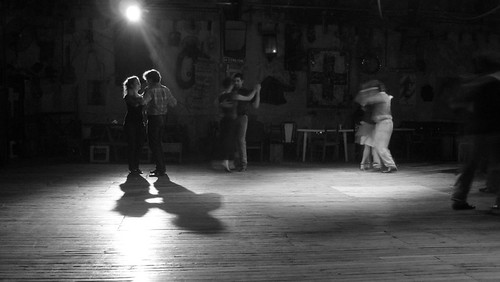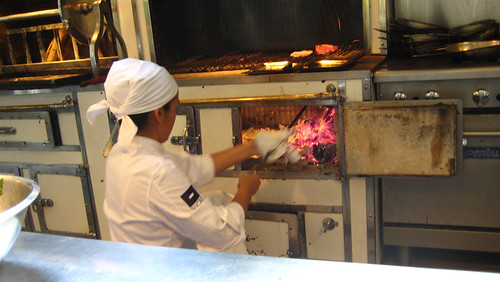Saw that this thread is getting a lot of international publicity .
http://food.theatlantic.com/abroad/what-makes-a-great-food-city.php
Is Buenos Aires A Great Food City?

Apologies for the neglect the past few weeks; we’ve been both traveling and sick (is there a worse combination?). But enough excuses, and on to the question at hand:
Is Buenos Aires A Great Food City?
That is the
question I came here to answer, after all. And it’s a hot subject of debate among the expats here, which you can read about on our discussion group where a thread titled “
Food Revolution Bypasses Buenos Aires” is now at 143 posts, with a total of fifteen pages devoted to the topic.
With three months here, and with much exploring and dozens of restaurant visits under our belt, I feel qualified to answer the question definitively. (For myself, at least.)
For me, a great food city is a place that caters to all manner of the food-obsessed: vibrant street food, affordable ethnic and traditional dining, and highly-acclaimed (and more importantly, highly-respected by their peers) destination restaurants. It should have a connection to its seasons and soil (or sea, as the case may be). It should be a place that can alternately surprise and comfort, at any budget level. On my personal list thus far I’d have to include places like San Francisco and the Bay Area, Madrid, Washington, DC (but not without a fair amount of effort), and Barcelona. (I hope to visit soon places like Montreal, San Sebastian, and Singapore, which I imagine will be added to this list.)
Buenos Aires doesn’t fit the bill, though.
Yes, there are many affordable steakhouses that specialize in the traditional Argentine cuisine of “
Meat. Fire. A Little Salt.” The problem is that there isn’t much to be found below or above it. That is, the street food scene is virtually nonexistent beyond empanadas. And in the “above” category, the popular restaurants like
Thymus,
Sucre,
Republica Brasas Resto,
788 Food Bar and others have left the worst taste of all in our mouths — the absence of flavor.
It’s not that all of these restaurants were bad (well,
a few were), but none of them were very good. I have had one meal in Argentina (the subject of a future post) that really hit all the right notes, and it was in the wine city of Mendoza, far from Buenos Aires.
The culprit? I blame it on the grill:

This is the kitchen at Sucre restaurant, one of the top-rated and -reviewed spots in the city. And they are using the same wood-fired grill as nearly every other restaurant in town.
In some ways, this could be a godsend. The
concept of cooking primitively is an attractive one and has proved successful for some, like the destination restaurant
Extebarri in Basque country where everything is grilled, even the
ice cream.
But at Sucre and other restaurants here, the grill becomes more of a crutch than a pedestal.
Menus consist mainly of wood-grilled proteins, but which are inadequately seasoned and sauced. When you grill salmon, halibut, shrimp or chicken over the same fire, without setting them apart in any way, it becomes tiresome. While the right sourcing and ingredients could provide variety in the absence of creativity, it doesn’t seem to be a priority here — there is little connection to the seasons and soil, a disturbing absence of the Alice Waters
philosophy. And when there are attempts at creativity, it just seems to
fall apart.
So one is left with eating a lot of steak (not necessarily a
bad thing), but pining for other flavors — something new, something
alive.
Maybe ten other food-obsessed thirtysomething drop-outs could come here and reach ten other conclusions than the ones I have. But I have the luxury of choosing where to spend my
pesos and expand my waistline, and my appetite is telling me it’s time to move on.
As Anthony Bourdain would say, “I’m hungry for more.” It would be a shame to spend all of our “retirement” in one place, on one cuisine. So we’re headed to other locales, which you’ll be reading about right here (with some additional thoughts and reports from Argentina). First up is a week in my hometown of Washington, DC, with a very full culinary calendar.
Although Buenos Aires hasn’t met my expectations as a great food city, it has been a wonderful beginning to “early retirement” and we really have enjoyed so many
steaks, empanadas,
raviolis,
cafes and
scoops of gelato here. If you want to spend a week eating world-beating ribeyes at ridiculously low prices, washed down with wine at “two buck chuck” prices but possessing qualities of a far more expensive red, this is the perfect place.
So
Chau, Argentina, and
Salud — thanks for the long nights chewing the fat (literally) at your
asados, the many afternoons pondering espresso in your cafes, and the tasty
Coca Cola. But you are a city better suited to gluttons than gourmands.
http://food.theatlantic.com/abroad/what-makes-a-great-food-city.php

